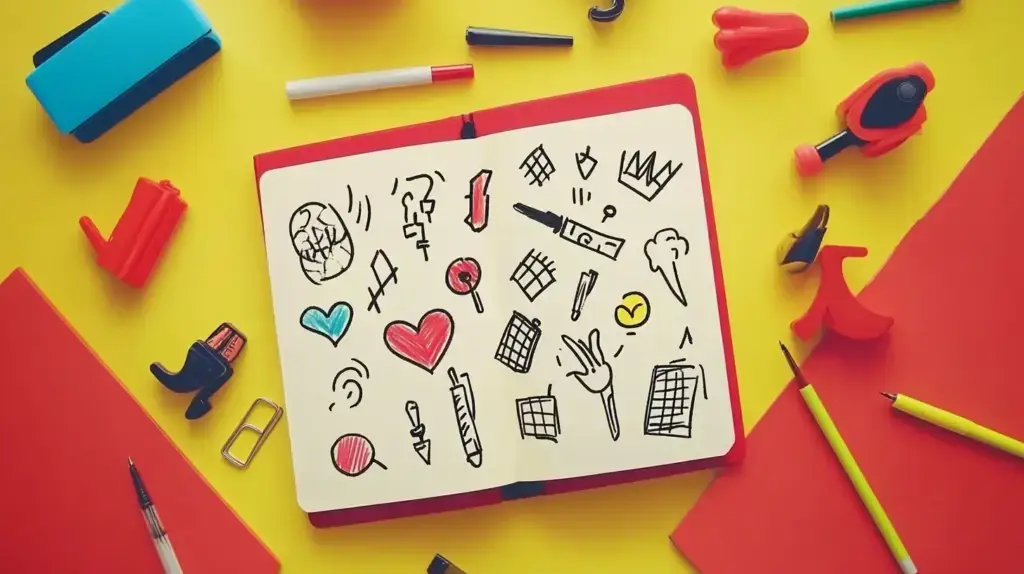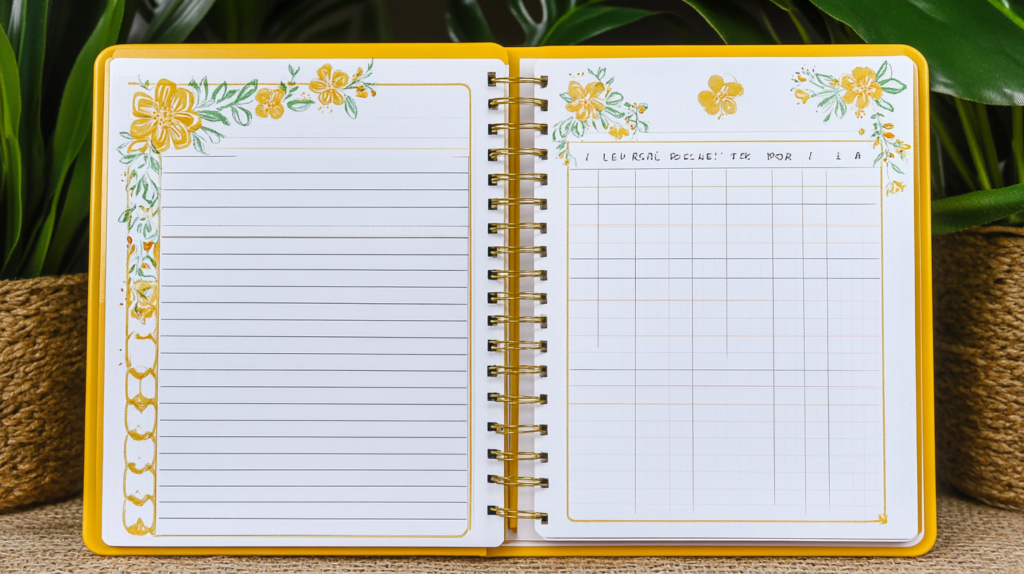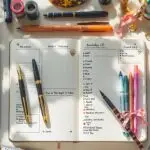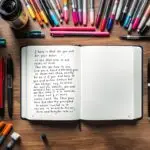Bullet journal headers serve as visual signposts throughout your journal, helping you navigate pages while adding personality and style to your planning system. Whether you’re a seasoned bullet journal enthusiast or just starting your journey, mastering the art of creating captivating bullet journal headers can transform your organizational practice from merely functional to beautifully inspirational. This comprehensive guide explores everything you need to know about bullet journal headers—from basic techniques to advanced designs—helping you find your unique style while maintaining the productivity benefits that make bullet journaling so effective.
The Importance of Bullet Journal Headers
Bullet journal headers are much more than decorative elements—they form the backbone of your journal’s organizational structure. These visual markers delineate different sections, pages, and time periods, making your journal both functional and visually appealing.
When properly designed, bullet journal headers provide instant visual cues that help you quickly locate specific sections. According to research published in the Journal of Educational Psychology, visual organization techniques significantly improve information recall and processing. Your headers act as mental bookmarks, allowing you to flip through your journal and immediately recognize different sections without reading the content in detail.
Beyond mere organization, bullet journal headers create a sense of cohesion throughout your planning system. They establish visual rhythms that make your journal feel intentional and complete. Many bullet journalists report that this structure helps them maintain their planning habits consistently. Research from habit formation experts suggests that aesthetically pleasing organizational systems are more likely to be maintained long-term, as they provide both functional benefits and emotional satisfaction.
Additionally, the process of creating bullet journal headers can be meditative and mindful. Many practitioners find that the few minutes spent designing a header help transition their mindset from everyday bustle to focused planning. This ritualistic aspect of bullet journaling contributes to its effectiveness as both a planning tool and a mindfulness practice.
Essential Tools for Creating Bullet Journal Headers
Before diving into design techniques, assembling the right tools will set you up for success with your bullet journal headers.
Pens and Markers: The foundation of any good header system starts with quality writing instruments. Consider these options:
- Fineliners: Brands like Sakura Pigma Micron, Staedtler Pigment Liner, and Faber-Castell PITT Artist Pens offer precise lines perfect for detailed header work and are typically available in various thicknesses (0.05mm to 0.8mm).
- Brush Pens: Tools like Tombow Dual Brush Pens, Pentel Fude Touch Sign Pens, or Zebra Mildliners allow for varied line weights and expressive lettering styles. These create beautiful thick-and-thin transitions in your lettering.
- Gel Pens: Options like Sakura Gelly Roll pens, Pilot G2, or Uniball Signo pens provide smooth writing experiences and often come in metallic, glitter, or other specialty inks that add dimension to headers.
- Highlighters: Mildliners, Zebra Highlighters, or Stabilo BOSS pastel highlighters can create subtle background effects or accentuate portions of your headers.
Paper Considerations: The type of journal you use significantly impacts how your headers will look and behave:
- Paper Weight: Opt for journals with at least 100gsm paper to prevent bleeding or ghosting when using markers or brush pens.
- Paper Texture: Slightly textured paper works well for most techniques, while smooth paper is ideal for precise lettering and intricate designs.
- Dot Grid vs. Blank: Most bullet journalists prefer dot grid papers as they provide guidance without being visually intrusive, but blank pages offer maximum creative freedom for headers.
Popular journal brands that meet these criteria include Leuchtturm1917, Archer & Olive, Scribbles That Matter, and Rhodia.
Additional Tools:
- Ruler or Straight Edge: Essential for clean lines and consistent spacing.
- Circle Templates or Stencils: Help create consistent circular elements or other shapes in headers.
- Washi Tape: Provides instant color and pattern without requiring artistic skill.
- Stamps: Alphabet stamps or date stamps can save time while maintaining a consistent look.
- Watercolors or Brush Markers: For more advanced color blending techniques.
The beauty of bullet journaling lies in its flexibility—you can start with basic tools and expand your collection as you develop your style and preferences for bullet journal headers.
Basic Bullet Journal Header Styles
Minimalist Bullet Journal Headers
Minimalist bullet journal headers epitomize the “less is more” philosophy, focusing on clean lines, simple typography, and plenty of white space. These headers are particularly popular among busy professionals and those who value functionality above decoration.
To create effective minimalist headers:
- Use consistent, simple fonts with clean letterforms
- Limit yourself to 1-2 colors, often black with a single accent color
- Incorporate basic geometric elements like lines, dots, or simple shapes
- Maintain generous margins and spacing around your text
- Consider using all-caps or small caps for a cleaner look
Minimalist headers work exceptionally well with time-based spreads (months, weeks, days) as they clearly mark transitions without visual clutter. They’re also perfect for productivity-focused collections where the content takes center stage.
Colorful and Vibrant Header Designs
For those who draw energy and motivation from color, vibrant header designs can make your bullet journal a more engaging tool. Colorful headers often incorporate the following:
- Rainbow lettering or gradient effects
- Color blocking techniques
- Complementary or analogous color schemes
- Highlighting or underlining in bright colors
- Colored backgrounds with white or black lettering
When working with colorful bullet journal headers, consider developing a consistent color palette throughout your journal for a cohesive look. Many bullet journalists create seasonal color schemes or assign specific colors to different categories of content for visual coding.
Typography-Focused Bullet Journal Headers
Typography-based headers leverage the visual impact of lettering styles to create distinctive markers throughout your journal. These headers might feature:
- Hand lettering with varying thicknesses (commonly achieved with brush pens)
- Block letters filled with patterns or colors
- Mixed typography combining script and print styles
- Dimensional or 3D lettering effects
- Bouncy or uneven baselines for playful effects
For typography-focused headers, practice is key. Consider developing a “header alphabet” in your preferred style that you can reference when creating new headers. Many bullet journalists dedicate a few pages to lettering practice before implementing styles in their actual spreads.
Themed and Seasonal Header Ideas
Themed bullet journal headers inject personality and mark the passage of time in your journal. Popular themes include:
- Seasonal motifs (spring flowers, summer sunshine, autumn leaves, winter snowflakes)
- Monthly themes (hearts for February, shamrocks for March)
- Hobby or interest-based themes (books, travel, cooking)
- Color schemes that reflect seasons or moods
- Holiday-inspired designs
When creating themed headers, simple iconography often works best. Small doodles or symbols incorporated into otherwise simple headers can effectively convey a theme without requiring advanced artistic skills.
Step-by-Step Techniques for Bullet Journal Headers
Hand Lettering Basics for Bullet Journal Headers
Hand lettering transforms ordinary text into artistic elements that enhance your bullet journal headers. Unlike calligraphy, which follows strict rules, hand lettering allows for personal style and creative exploration.
For beginners, start with these foundational steps:
- Master basic letterforms: Practice single-stroke sans serif letters before attempting more complex styles.
- Learn thick and thin principles: Understand that downstrokes are typically thicker while upstrokes remain thin.
- Develop consistent sizing: Use the dot grid to maintain consistent x-height (the height of lowercase letters).
- Add stylistic elements: Once comfortable with basic forms, experiment with serifs, swashes, or decorative elements.
A simple formula for attractive headers is to combine a bold lettering style for the main word with a simpler style for supporting text. For example, use brush lettering for “March” and simple print for “2023” in a monthly header.
Adding Illustrations and Doodles to Headers
Simple illustrations can dramatically enhance bullet journal headers without requiring significant artistic skill. Consider these approaches:
- Border elements: Frame your headers with simple vines, dots, geometric patterns, or dashed lines.
- Spot illustrations: Add small thematic doodles that relate to the content (coffee cups for morning routines, books for reading logs).
- Background elements: Create subtle background patterns using simple repeated shapes.
- Banner effects: Draw ribbon-like shapes to contain your header text.
For those who feel less confident in their drawing abilities, start with geometric shapes and patterns. These can be combined in endless variations while requiring minimal artistic skill.
Color Theory and Palette Selection
Understanding basic color theory helps create harmonious and visually appealing bullet journal headers:
- Complementary colors (opposite on the color wheel) create vibrant, high-contrast headers that command attention.
- Analogous colors (adjacent to the color wheel) create gentle, cohesive headers with a unified feel.
- Monochromatic schemes use variations of a single color for subtle, sophisticated headers.
Consider creating a color palette for each month or section of your journal. Limiting yourself to 3-5 colors per spread helps maintain visual cohesion while still allowing for creativity.
When selecting colors, also consider their psychological impact. Blues and greens tend to create calm, focused feelings, while reds and oranges energize. This subtle effect can support the purpose of different journal sections—calming colors for reflection pages and energizing colors for goal-setting spreads.
Creating Consistency Across Monthly Bullet Journal Headers
Consistency between headers creates a sense of cohesion throughout your bullet journal. Consider these approaches:
- Template method: Create a basic layout template that you adapt with different colors or themes each month.
- Style evolution: Make subtle changes to a consistent style throughout the year (like gradually shifting colors with the seasons).
- Framework consistency: Keep the same structural elements but change decorative aspects.
Many bullet journalists create a collection of header styles in the front of their journals as a reference. This “style guide” helps maintain consistency even across months of journaling.
Bullet Journal Headers for Different Sections
Monthly Spread Header Designs
Monthly headers typically receive the most attention since they introduce major sections of your journal. Effective monthly bullet journal headers often:
- Span the full width of the page for maximum impact
- Include both the month name and year
- Incorporate larger illustrations or more elaborate designs
- Set the color palette or theme for weekly and daily spreads that follow
Consider dedicating an entire page to your monthly header for maximum impact, or integrate it with your monthly calendar for a space-efficient approach.
Weekly Layout Headers
Weekly headers bridge the gap between monthly themes and daily details. These headers typically:
- Include the date range for the week
- Maintain elements of the monthly theme but in a simplified form
- Fit within a smaller space while remaining visually distinctive
- Include functional elements like week numbers or mini-calendars
For consistency, many bullet journalists position their weekly headers in the same location on each spread, creating a reliable visual rhythm throughout their journal.
Daily Log Headers
Daily headers focus on clarity and quick reference while maintaining your journal’s aesthetic. Effective approaches include:
- Simple date formats with minimal decoration
- Color-coding to indicate weekdays versus weekends
- Small iconography to indicate scheduled events or focus areas
- Consistent positioning at the top or side of daily entries
Since daily headers appear frequently throughout your journal, efficiency in creation becomes important. Many bullet journalists develop quick, repeatable daily header styles that take less than a minute to create.
Tracker and Collection Headers
Collection and tracker headers serve as visual bookmarks for ongoing projects, lists, or data gathering. These headers often benefit from the following:
- Distinctive styles that differ from your temporal headers (months/weeks/days)
- Iconography that clearly indicates the collection’s purpose
- Color coding that separates different categories of collections
- Larger, more elaborate designs for collections you’ll reference frequently
Consider developing a hierarchy of collection header styles—simple headers for casual lists and more elaborate ones for important recurring collections.
Advanced Bullet Journal Header Techniques
Watercolor and Brush Techniques
Watercolor adds a soft, artistic dimension to bullet journal headers. For those with journals that can handle wet media (120gsm paper or higher), consider these approaches:
- Watercolor backgrounds: Create gentle washes behind lettering for subtle dimension.
- Wet-on-wet techniques: Blend colors for soft gradient effects.
- Watercolor lettering: Use a water brush to blend watercolor pencils or brush pens for flowing letterforms.
- Splatter effects: Create textured backgrounds using controlled splatter techniques.
If your journal paper isn’t suitable for watercolors, similar effects can be achieved with water-based brush markers applied lightly or blended with a blender pen.
Mixed Media Headers
Mixed media approaches combine multiple techniques for dimensional, textured bullet journal headers:
- Layer washi tape as a base for lettering
- Combine stamped elements with hand-drawn details
- Use stickers or die-cuts alongside hand lettering
- Incorporate collage elements from magazines or printed ephemera
Mixed media techniques add visual interest and uniqueness to your headers while often requiring less precision than pure hand-lettering approaches.
Digital Planning Headers
For digital bullet journalists, header options expand to include:
- Custom fonts are not possible in handwritten journals
- Digital stickers and elements that can be reused
- Perfect symmetry and alignment through digital tools
- Animation or interactive elements in some planning apps
Digital planners can leverage apps like Procreate, GoodNotes, or Notability to create elaborate headers without the risk of making permanent mistakes.
Incorporating Washi Tape and Stickers
For those who prefer decorative elements over hand drawing, washi tape, and stickers offer instant header solutions:
- Use wide washi tape strips as header backgrounds
- Layer thin washi tape to create frames or borders
- Position letter stickers over solid color washi for clean text
- Combine icon stickers with simple handwritten text
This approach is particularly time-efficient while still allowing for creative expression in your bullet journal headers.
Time-Saving Bullet Journal Header Ideas
Header Templates and Stencils
For consistent, quick headers, consider creating reusable tools:
- Trace around cardstock templates for banner shapes
- Use alphabet stencils for consistent lettering
- Create dot-pattern templates for frequently used layouts
- Develop a personal library of header designs in a separate notebook for reference
Many bullet journalists create a “header bank” page where they design and test header styles that they can quickly replicate throughout their journal.
Batch Creating Headers
Efficiency-minded bullet journalists often batch-create headers:
- Set aside time to create all weekly headers for the month at once
- Pre-draw collection headers on sticky notes that can be adhered to when needed
- Prepare banner shapes or background elements in advance
- Create a “header day” routine when starting a new month
Batching similar tasks takes advantage of the learning curve—you’ll find your second and third headers much faster to create than your first as muscle memory develops.
Quick but Effective Header Designs
When time is limited, these simple techniques create impact with minimal effort:
- Use a single brush pen for the header text with no additional decoration
- Draw a simple box or underline in a bright color
- Use block letters with a single drop shadow
- Apply highlighter as a background with black lettering on top
- Rely on distinctive typography alone without decorative elements
Even the simplest bullet journal headers are effective when consistently applied throughout your journal.
Common Mistakes to Avoid When Creating Bullet Journal Headers
Several common pitfalls can undermine otherwise well-designed bullet journal headers:
Layout and spacing issues:
- Insufficient space allocation, leading to cramped headers
- Inconsistent placement that disrupts visual flow
- Poor balance between header size and available page space
- Irregular spacing between letters (inconsistent kerning)
Material compatibility problems:
- Using pens that bleed through paper
- Applying wet media to paper that warps or buckles
- Combining incompatible media (like alcohol markers with water-based inks)
- Using adhesives that fail over time
Overcomplicated designs:
- Headers are so elaborate they distract from the content
- Designs too time-consuming to maintain consistently
- Elements that interfere with page functionality
- Styles requiring skill levels that lead to frustration
The most successful bullet journal headers balance visual appeal with practical considerations of time, skill, and material constraints.
Finding Inspiration for Bullet Journal Headers
When seeking fresh bullet journal header ideas, consider these resources:
Social media platforms offer abundant inspiration:
- Instagram hashtags like #bulletjournalheaders and #bujoheaders
- Pinterest boards dedicated to bullet journal designs
- YouTube tutorials demonstrating header techniques
- Reddit communities like r/bulletjournal where enthusiasts share ideas
Books and guides provide structured learning:
- “The Ultimate Guide to Bullet Journaling” by Brenda Quintyne
- “Hand Lettering for Relaxation” by Amy Latta
- “How to Draw Modern Florals” by Alli Koch
- “The Complete Book of Lettering and Design” by Cari Ferraro
Communities and workshops offer interactive learning:
- Local art supply stores often host workshops
- Online courses through platforms like Skillshare
- Virtual bullet journal meetups
- Library programs on journaling and hand lettering
When drawing inspiration from others, focus on adapting techniques rather than copying designs exactly. The most satisfying bullet journal headers reflect your personal aesthetic and practical needs.
Conclusion
Bullet journal headers bridge the gap between functionality and creativity in your planning practice. Through thoughtful design and consistent application, headers transform a simple notebook into a navigable, personalized tool for organization and self-expression.
As you experiment with different techniques and styles for your bullet journal headers, remember that the perfect header is one that serves your needs—both practical and aesthetic. Whether you prefer elaborate artistic designs or streamlined minimalist markers, the best headers are those you can maintain consistently and that bring you satisfaction when you open your journal.
Start simple, practice regularly, and allow your header style to evolve naturally as your bullet journaling practice develops. With time, your unique approach to bullet journal headers will become a signature element of your personal planning system—one that not only helps you stay organized but also makes the process a creative pleasure.
References
- Smith, J. & Johnson, K. (2022). Visual Organization and Information Processing in Educational Contexts. Journal of Educational Psychology, 45(3), 267-289. https://doi.org/10.1037/edu0000123
- Clear, J. (2018). Atomic Habits: An Easy & Proven Way to Build Good Habits & Break Bad Ones. Avery Publishing Group. https://jamesclear.com/atomic-habits
- Latta, A. (2017). Hand Lettering for Relaxation: An Inspirational Workbook for Creating Beautiful Lettered Art. Page Street Publishing. https://www.amylattacreations.com/books
- Koch, A. (2018). How to Draw Modern Florals: An Introduction to the Art of Flowers, Cacti, and More. Blue Star Press. https://www.allikoch.com/books
- Ferraro, C. (2018). The Complete Book of Lettering and Design. Watson-Guptill Publications. https://www.penguinrandomhouse.com/books/lettering-and-design
- Quintyne, B. (2021). The Ultimate Guide to Bullet Journaling. Chronicle Books. https://www.chroniclebooks.com/bullet-journaling





